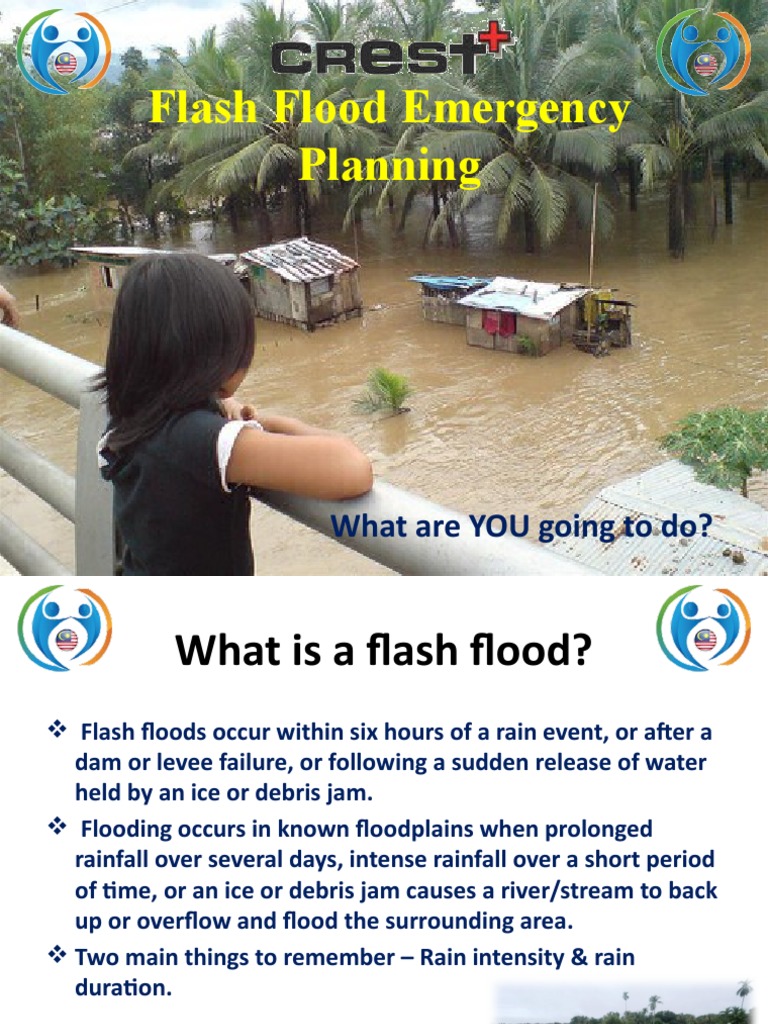Flash Flood Emergency: Causes, Effects, And Mitigation Strategies

Table of Contents
Understanding the Causes of Flash Flood Emergencies
Several factors contribute to the occurrence of flash flood emergencies. Understanding these causes is the first step toward effective prevention and mitigation.
Intense Rainfall
Intense rainfall is the most common cause of flash floods. Heavy downpours, particularly those lasting only a short period, can overwhelm natural and man-made drainage systems.
- Rainfall exceeding 2-3 inches in a short duration (e.g., 6 hours) can easily lead to flash flooding, especially in areas with poor drainage.
- Saturated ground, from previous rainfall or snowmelt, significantly reduces the ground's absorption capacity, exacerbating the risk.
- Thunderstorms, with their concentrated bursts of heavy rain, are particularly dangerous flash flood triggers. The sudden deluge overwhelms drainage systems, leading to rapid water accumulation.
For example, the 2016 Baton Rouge, Louisiana floods resulted from intense rainfall exceeding 20 inches in just a few days, showcasing the devastating consequences of heavy precipitation.
Dam Failures and Water Releases
While less frequent, dam failures and uncontrolled water releases from dams can also cause catastrophic flash floods downstream.
- Aging infrastructure, inadequate maintenance, and unforeseen events (e.g., earthquakes) can lead to dam failures.
- Controlled releases, while sometimes necessary for dam safety, can also contribute to downstream flooding if not managed carefully. Effective warning systems are vital in these situations.
The Johnstown Flood of 1889, caused by a dam failure, serves as a tragic example of the devastating consequences of dam breaches. Thousands perished in the resulting flash flood.
Rapid Snowmelt
In mountainous regions, rapid snowmelt can trigger flash floods, particularly when combined with heavy rainfall or unusually warm temperatures.
- Warm temperatures and/or sudden rainfall accelerate snowmelt, dramatically increasing water volume in rivers and streams.
- Areas with steep slopes and limited vegetation are especially vulnerable to flash floods from rapid snowmelt.
The spring melt in the Rocky Mountains frequently leads to localized flash floods, highlighting the risk associated with rapid snowmelt in these regions.
Urbanization and Infrastructure
Urban development significantly increases the risk of flash floods. Inadequate infrastructure contributes to the problem.
- Impermeable surfaces like concrete and asphalt prevent water absorption, increasing runoff.
- Clogged drains and insufficient drainage capacity further exacerbate the situation.
- Deforestation reduces the land's ability to absorb rainfall, leading to increased runoff.
Many cities worldwide face increased flash flood risk due to urbanization and its impact on water management. Areas with poor drainage systems are particularly vulnerable.
Devastating Effects of Flash Flood Emergencies
The consequences of flash flood emergencies are far-reaching and devastating, impacting lives, property, and the environment.
Loss of Life and Injury
Flash floods are a leading cause of weather-related deaths globally. The rapid and powerful currents pose a significant threat.
- Drowning is the most common cause of death in flash floods.
- Injuries from debris, collapsing structures, and the force of the water are also frequent.
- The psychological trauma experienced by survivors can have long-lasting effects.
Numerous examples exist of flash floods causing widespread loss of life, underscoring the urgent need for effective prevention and response measures.
Property Damage and Economic Losses
The economic burden of flash floods is substantial. Homes, businesses, and infrastructure suffer extensive damage.
- Flooding causes water damage, destroying belongings and rendering structures uninhabitable.
- Erosion can undermine foundations and damage roads and bridges.
- Debris carried by floodwaters causes further damage to property.
- The disruption to businesses and loss of livelihoods create significant economic hardship.
The cost of repairs, rebuilding, and economic recovery can run into billions of dollars after a major flash flood event.
Environmental Impacts
Flash floods severely impact the environment, causing widespread damage to ecosystems.
- Soil erosion removes topsoil, leading to land degradation and impacting agricultural productivity.
- Habitat destruction affects wildlife populations, leading to loss of biodiversity.
- Pollutants from flooded areas contaminate water sources, harming aquatic life and posing risks to human health.
The long-term consequences of flash floods on the environment can be significant and long-lasting.
Mitigation Strategies for Flash Flood Emergencies
Effective mitigation strategies are vital for reducing the impact of flash flood emergencies. A multi-pronged approach is necessary.
Early Warning Systems
Early warning systems are crucial for providing timely alerts and allowing people to take protective action.
- Weather forecasts, river gauges, and other monitoring systems provide crucial data.
- Effective communication networks are vital for disseminating warnings to the public.
- Sirens and other alert systems are effective for immediate warnings in high-risk areas.
Robust early warning systems improve response times and save lives.
Land Use Planning and Infrastructure Development
Sustainable urban planning is essential for reducing flood risk.
- Increased green spaces help absorb rainfall and reduce runoff.
- Permeable pavements allow water to seep into the ground.
- Improved drainage systems help manage excess water more efficiently.
- Flood-resistant construction techniques protect buildings from damage.
Investing in robust infrastructure is a critical long-term solution.
Public Awareness and Education
Educating the public about flood risks and safety measures is vital.
- Educational campaigns targeting different demographics can raise awareness.
- Teaching people about emergency plans and evacuation routes is crucial.
- Public awareness programs should include information on flood insurance and how to prepare emergency kits.
Increased public awareness leads to better preparedness and reduces vulnerabilities.
Emergency Preparedness and Response
Individual and community preparedness is essential for mitigating the impact of flash floods.
- Develop a family emergency plan, including evacuation routes and meeting points.
- Assemble an emergency kit with essential supplies (water, food, first-aid kit, etc.).
- Understand flood insurance options and the process for filing claims.
- Participate in community preparedness initiatives and drills.
Proactive preparedness saves lives and minimizes the impact of flash floods.
Conclusion
Flash flood emergencies are devastating events with far-reaching consequences. Understanding their causes – intense rainfall, dam failures, rapid snowmelt, and inadequate urban infrastructure – is the first step toward effective mitigation. The devastating effects – loss of life, property damage, and environmental impacts – highlight the urgent need for comprehensive strategies. By implementing early warning systems, promoting sustainable land use planning, educating the public, and fostering emergency preparedness, we can significantly reduce the vulnerability of communities to flash flood emergencies. Learn more about your local flood risks, develop a personal emergency plan, and participate in community preparedness initiatives. Together, we can make a difference in protecting lives and property from future flash flood emergencies. For further information and resources, contact your local emergency management agency or national weather service.

Featured Posts
-
 Upset In Rome Zheng Qinwen Beats Sabalenka At Italian Open
May 25, 2025
Upset In Rome Zheng Qinwen Beats Sabalenka At Italian Open
May 25, 2025 -
 Nvidias Rtx 5060 Expectations Vs Reality A Review Analysis
May 25, 2025
Nvidias Rtx 5060 Expectations Vs Reality A Review Analysis
May 25, 2025 -
 Planning Your Memorial Day Trip Smartest Flight Dates For 2025
May 25, 2025
Planning Your Memorial Day Trip Smartest Flight Dates For 2025
May 25, 2025 -
 2nd Edition Best Of Bangladesh In Europe Showcases Collaboration And Economic Growth
May 25, 2025
2nd Edition Best Of Bangladesh In Europe Showcases Collaboration And Economic Growth
May 25, 2025 -
 Net Asset Value Nav Explained Amundi Msci All Country World Ucits Etf Usd Acc
May 25, 2025
Net Asset Value Nav Explained Amundi Msci All Country World Ucits Etf Usd Acc
May 25, 2025
Latest Posts
-
 Italian Open Chief Top Players Elevate Chinese Tennis Culture
May 25, 2025
Italian Open Chief Top Players Elevate Chinese Tennis Culture
May 25, 2025 -
 Italian Open Zheng Qinwen Through To Last 16
May 25, 2025
Italian Open Zheng Qinwen Through To Last 16
May 25, 2025 -
 Chinese Tennis Sensation In Italian Open Quarterfinals
May 25, 2025
Chinese Tennis Sensation In Italian Open Quarterfinals
May 25, 2025 -
 Zheng Qinwen Advances To Italian Open Last 16
May 25, 2025
Zheng Qinwen Advances To Italian Open Last 16
May 25, 2025 -
 Italian Open Chinese Tennis Player Secures Quarterfinal Spot
May 25, 2025
Italian Open Chinese Tennis Player Secures Quarterfinal Spot
May 25, 2025
